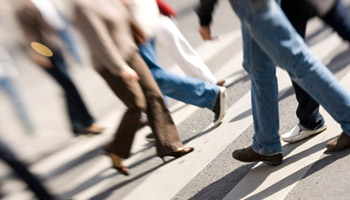 To stay safe walking, follow these rules of the road:
To stay safe walking, follow these rules of the road:
- Walk Facing Traffic: If there is no sidewalk and you must walk on the side of the road, choose the side where you are facing oncoming traffic. In North America, this is the left side of the road. This gives you the best chance to see traffic approaching closest to you and take evasive action when needed.
- Cross Safely: Mom was right: look both ways before crossing any street. At controlled intersections, it is wise to cross only when you have the pedestrian crossing light, but even then, drivers and bikers may have a green light to turn and won’t be expecting you to be in the crosswalk. Make eye contact with any drivers who may be turning. Give them a wave. Make sure they see you. In a car-walker interaction, you can only lose.
- Walk Single File: Unless you are on a sidewalk separated from the road or a wide bike lane, you should walk in single file. This is especially important on a road with lots curves, where traffic has only a split second chance of seeing you before hitting you. While it can be enjoyable to walk down the road two to three abreast chatting merrily, drivers don’t expect it and you may lose your best walking buddies.
- Stay Aware of Bikes and Runners: Share the road and path with bikes and runners. Bike riders should alert you when approaching from behind with a bike bell or a “passing on the left/right.” Listen for them, and move to walk single file, allowing them to pass safely. Runners should also call out for passing. Bike-walker collisions can result in broken bones or head injury for either — and you aren’t wearing a helmet.
- Be Visible: Wear bright colors when walking in daytime. When walking at night, wear light-colored clothing and reflective clothing or a reflective vest to be visible. Drivers are often not expecting walkers to be out after dark, and you need to give them every chance to see you, even at street crossings that have crossing signals. Be just as cautious at dawn or twilight, as drivers still have limited visibility or may even have the setting or rising sun directly in their eyes.
- Be Predictable: Make a practice of staying on one side of the path while walking rather than weaving randomly from side to side. Watch your arm motions, or you may end up giving a black eye to a silently passing walker, runner or biker.
- Keep the Volume Down: Don’t drown out your environment with your iPod. Keep the volume at a level where you can still hear bike bells and warnings from other walkers and runners. Your audiologist will also thank you.
- Hang Up and Walk: Chatting on a cell phone while you walk is as dangerous as chatting while driving. You are distracted and not as aware of your environment. You are less likely to recognize traffic danger, passing joggers and bikers or tripping hazards. Potential criminals see you as a distracted easy target.
- Walk Dogs on Short Leashes: I’ve seen many tragedies of dogs running out in to traffic or getting into a fatal dog fight either off leash or on a very long leash. Don’t trip up other walkers or bikers with poor control of your pet. Keep your pet and yourself safe by learning proper leash walking.
- Know When to Stop Walking: Heat sickness, dehydration, heart attack or stroke can strike walkers of any age. Learn the symptoms of medical emergencies and carry a cell phone to dial 911.
- Be Aware of Stranger Danger: Choose your walking route for paths frequented by other walkers, joggers and bikers. If you see someone suspicious, be prepared to alter your course or go in to a store or public building to avoid them. Acting alert and aware can convince bad guys to choose an easier target.
via Walking Safety Rules.
